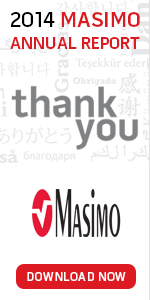| SpO2 Universal Resposable Sensors | SofTouch™ Sensors | Specialty Sensors | Multisite |
| M-LNCS™ | LNCS® Sensors | LNOP® Sensors | ||||||||
| Adhesive | Reusable | Cables | Adhesive | Reusable | Cables | Adhesive | Reusable | Cables | ||
E1™ Ear Sensor
Faster Detection of Oxygen Saturation Changes with a Single-Patient-Use Sensor Designed for the Ear Concha
While Masimo SET® Measure-through Motion and Low Perfusion™ pulse oximetry overcomes the limitations of conventional pulse oximetry and offers 97% sensitivity and 95% specificity for alarms during motion and low perfusion conditions1, there are still some advantages to monitoring on the head such as faster response to oxygenation changes during low perfusion and the use of an alternative site when the digit is unavailable.
As a single-patient-use ear sensor that is placed securely in the cavum conchae (the deep hollow near the ear canal opening), the E1 allows clinicians to combine Masimo SET® performance with a reliable alternative monitoring site while minimizing cross-contamination.
LNCS® E1 Sensor

M-LNCS® E1 Sensor
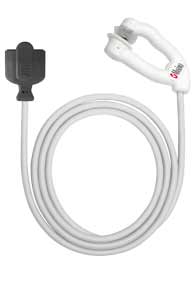
Advantages of Single-Patient-Use versus Reusable Sensors
- > Avoids cross-contamination risks
- > Reduces complexity of reusable ear sensor management (cleaning, storage, and inter-departmental transport)
Advantages of Head versus Digit Monitoring
- > Faster detection of desaturation / resaturation compared to digit sensors during low perfusion2
- > Alternate monitoring site with easy access during surgery, resuscitation, in patients with finger deformities, or when digit access is not possible
- > Offers reliable measurements during extremely low perfusion when Masimo Max™ Sensitivity setting is not enabled3
- > Allows for hands-free monitoring
- > Ear site may offer advantages for pleth variability (PVI®) monitoring to help clinicians assess fluid responsiveness4
Advantages of Ear versus Forehead Monitoring
- > Alleviates known accuracy limitations of forehead sensors including venous pulsations and when patients are in a supine or Trendelenburg position2,5
- > Provides alternative to digit sensor when forehead site is unavailable (brain function monitoring, cerebral oxygenation monitoring, or neck stabilization during trauma)
Advantages of Cavum Conchae versus Ear Lobe Monitoring
- > Stays in place more securely than traditional clip-style sensors on ear lobe
- > Sensor location offers better perfusion than ear lobe for improved signal quality
Newborn Sensors
Provides the fastest response time and maximum sensitivity, allowing immediate support for newborn resuscitation—when accurate SpO2 monitoring is critical.
- > When connected to a Masimo SET®-enabled monitor, Newborn sensors immediately and automatically configure the device for fastest response time and highest sensitivity.
- > Fast response Newborn sensors together with Masimo SET® technology deliver critically accurate data instantly.
- > Quick and easy application and repositioning of sensor with a VelAid™ SofTouch™ hook and loop attachment strip, allowing for fast and secure application to the newborn skin—even when wet.
LNOP® Sensors

Neonatal
< 3 kg

Infant/Pediatric
3 kg - 30 kg
LNCS® Sensors

Neonatal
< 3 kg

Infant/Pediatric
3 kg - 30 kg
M-LNCS™ Sensors

Neonatal
< 3 kg

Infant/Pediatric
3 kg - 30 kg
"Time is crucial when infants are struggling for life. Masimo's Newborn sensor helps clinicians maximize the time we can spend caring for patients. During newborn resuscitation, frequently other oximeters don't work. With Masimo, we have been able to successfully track newborn resuscitation."
- Dr. Mitchell Goldstein
Pomona Valley Hospital Medical Center
in Pomona, California
"During resuscitation, it is beneficial to have minimal averaging of the SpO2 values coupled with maximal sensitivity, and one manufacturer has developed a probe that, when connected, can reprogram the oximeter to function in this manner."
- Dr. Neil N. Finer
NeoReviews Vol.6 No.4 April 2005
Accurate monitoring of a newborn's SpO2 during the first seconds of life is critical. The American Academy of Pediatrics' 2005 Neonatal Resuscitation Protocol for pre-term infants recommends using a blend of air and oxygen for resuscitation and a pulse oximeter for monitoring oxygenation. However, it can be challenging to obtain accurate SpO2 measurements because the newborn is damp, and often shivering, crying and poorly perfused.
The Newborn Sensor, combined with Masimo SET® or Masimo rainbow SET® technology, gives clinicians the high levels of sensitivity and specificity needed to provide accurate SpO2 readings during these challenging conditions. When connected to Masimo oximeters and patient monitors equipped with Masimo SET®, this innovative sensor immediately enables the fastest response time and maximum sensitivity. The sensor's VelAid hook-and-loop attachment strip and adhesive emitter and detector strip allows quick application and stays secure even when the site is wet.
Newborn Sensors allow the clinician to focus their attention on their patients instead of using valuable seconds trying to configure instruments and select an appropriately matched sensor to achieve the most accurate readings possible. The fast response Newborn Sensors together with Masimo SET® deliver critically accurate data instantly.
Trauma Sensor
The highest resolution, most accurate and rapid SpO2 and Pulse Rate measurements when they matter most.
- > A sensor specifically designed to provide immediate support for emergent resuscitation interventions in pediatrics and adults when time is critical.
- > Provides the fastest response times (lowest averaging) and highest sensitivity on Masimo SET® oximeters and multiparameter monitors equipped with Masimo SET® Oximetry.
- > Enables clinicians to focus complete attention to addressing the needs of their patients. Valuable seconds are preserved for patient care, not monitor configuration.
- > VelAid™ SofTouch™ design allows for quick and easy application and repositioning of sensor with hook and loop attachment strip—stays secure even when site is wet.
Adult Sensor
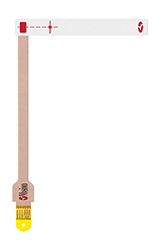
LNOP® Trauma
> 30 kg
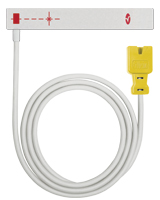
LNCS® Trauma
> 30 kg
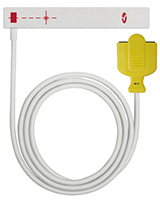
M-LNCS™ Trauma
> 30 kg
"During resuscitation, it is beneficial to have minimal averaging of the SpO2 values coupled with maximal sensitivity, and one manufacturer has developed a probe that, when connected, can reprogram the oximeter to function in this manner (Masimo Corp. Irvine, California)."
- Dr. Neil N. Finer
NeoReviews Vol.6 No.4 April 2005
Monitoring oxygen staturation through pulse oximetry is a standard of care in trauma settings, such as the emergency room. These devices help to prevent the critical loss of time.
The Trauma Sensor, combined with Masimo SET® or Masimo rainbow SET® technology, gives clinicians the high levels of sensitivity and specificity needed to provide accurate SpO2 readings during these challenging conditions. When connected to Masimo oximeters and patient monitors equipped with Masimo SET®, this innovative sensor immediately enables the fastest response time and maximum sensitivity. The sensor's VelAid hook-and-loop attachment strip and adhesive emitter and detector strip allows quick application and stays secure even when the site is wet.
The Trauma Sensor allows the clinician to focus their attention on their patients instead of using valuable seconds trying to configure instruments and select an appropriately matched sensor to achieve the most accurate readings possible. The fast response Trauma Sensor together with Masimo SET® delivers critically accurate data instantly.
Masimo Blue® Sensors
A breakthrough sensor specifically designed for cyanotic infants and children with congenital heart disease
- > Specifically for cyanotic neonates, infants and children with congenital heart disease (CHD), the sensor is designed exclusively to maximize accuracy in this vulnerable patient population
- > Proven accurate on cyanotic patients with oxygen saturations as low as 60%6
- > Maximum SpO2 accuracy and reliability allows better management of cardiac medications and ventilation therapy6
Obtaining accurate and reliable SpO2 measurements on pediatric patients with congenital heart disease has frequently been impossible. This has affected clinicians’ ability to rely on continuous SpO2 measurements to provide care for these patients.
After extensive research and development, Masimo introduced the Blue sensor, the first pulse oximetry sensor designed specifically for cyanotic neonates, infants, and children. The Masimo Blue sensor is proven accurate to saturations as low as 60%.
The Masimo Blue sensor provides reliable, continuous pulse oximetry that clinicians need to better manage cardiac medications and ventilation therapy of these critical patients.
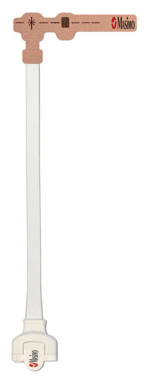
M-LNCS Blue
2.5 kg - 30 kg
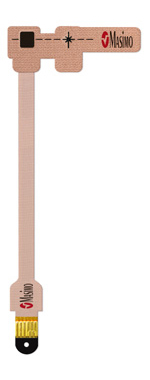
Blue
2.5 kg - 30 kg
PDF Resources
 Sell Sheet:
Sell Sheet:Newborn Sensors |
 Sell Sheet:
Sell Sheet:Trauma Sensor |
 Brochure:
Brochure:E1 Sensor |
 Sell Sheet:
Sell Sheet:Blue Sensor |
- Shah N et al. J Clin Anesth. 2012 May 22.
- Tokuda K et al. Anesthesiology. 2007;107:A1544.
- Redford DT et al. Anesth Analg. 2004;98(2S):S-94.
- Pavlakovitch I et al. Eur J Anaesthesiol. 2011; May:Abs 1306.
- The OXIMAX MAX-FAST sensor is contraindicated for patients who exhibit allergic reactions to the adhesive pad; for patients who perspire profusely; or under conditions where the patient is in the Trendelenburg position (head lower than the heart).
- Whitney GM, et al. Anesthesiology. 2005; 103:A1344






